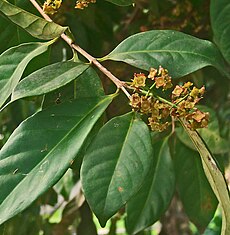Lourierblaar


Lourierblare verwys na die geurige blare van verskeie plante soos die Cinnamomum tamala en Syzygium polyanthum wat in die kookkuns gebruik word. Hulle bevat sowat 1,3% essensiële olies.
As dit heel geëet word, het lourierblare ’n skerp, bitter smaak. Soos met baie speserye en geurmiddels, is die reuk van die blare skerper as die smaak. Wanneer dit gedroog is, is die reuk kruidagtig, effens blomagtig, en taamlik soortgelyk aan origanum en tiemie.
Gebruike
[wysig | wysig bron]Lourierblare word dikwels in Indiese en Pakistanse kos gebruik, veral in rysgeregte soos biryani, en as ’n bestanddeel in garam masala. In Suid-Afrika word dit ook in bobotie gebruik.
Lourierblare is deur die antieke Grieke as geurmiddel gebruik.[1] Dit word vandag steeds in baie Europese geregte gebruik (veral in die Middellandse Seegebied). Dit kom voor in bredies, seekos, groentegeregte en souse en in klassieke Franse geregte. Dit word dikwels heel gebruik en ná die kookproses verwyder. In die Thaise kookkuns word lourierblare ook gebruik in ’n paar Arabies geïnspireerde geregte.[2]
Lourierblare kan ook voor die kookproses fyngemaal word. Dit het meer smaak as heel blare, maar is moeiliker om te verwyder; daarom word hulle dikwels is ’n sakkie in die kos geplaas.
Lourierblare kan ook in ’n spens gestrooi word om meelmotte,[3] vlieë,[4] kakkerlakke,[5] muise en silwermotte weg te hou.
Verwysings
[wysig | wysig bron]- ↑ "Ancient Egyptian Plants: Trees" www.reshafim.org.il Geargiveer 31 Oktober 2013 op Wayback Machine Besoek op 29 Oktober 2013
- ↑ Tan, Hugh T. W. (2005). Herbs & Spices of Thailand. Marshall Cavendish. p. 71.
- ↑ "How to Repel Grain Moths with Bay Leaves". Geargiveer vanaf die oorspronklike op 7 Desember 2010. Besoek op 11 April 2009.
- ↑ Palacios, S; Bertoni, A; Rossi, Y; Santander, R; Urzua, A (2009). "Efficacy of Essential Oils from Edible Plants as Insecticides Against the House Fly, Musca domestica L." Molecules. 14 (5): 1938–1947. doi:10.3390/molecules14051938.
- ↑ Naturally Occurring Pest Bioregulators - ACS Symposium Series (ACS Publications) (in Engels). doi:10.1021/bk-1991-0449.
Eksterne skakels
[wysig | wysig bron]- "Bay Leaf: Should It Stay or Should It Go?" washingtonpost.com, 30 September 2014.
 Hierdie artikel is vertaal uit die Engelse Wikipedia
Hierdie artikel is vertaal uit die Engelse Wikipedia
Text is available under the CC BY-SA 4.0 license; additional terms may apply.
Images, videos and audio are available under their respective licenses.
